Investigation of the Reaction between a Homemade PEEK Oligomer and an Epoxy Prepolymer: Optimisation of Critical Parameters Using Physico–Chemical Methods
Abstract
1. Introduction
2. Materials and Methods
2.1. Chemicals
2.2. Blend Preparation
2.3. Fourier Transform InfraRed (FTIR) Analyses
2.4. Nuclear Magnetic Resonance (NMR) Analyses
2.5. Size Exclusion Chromatography (SEC) Experiments
2.6. Differential Scanning Calorimetry (DSC) Analyses
2.7. Thermogravimetric Analyses (TGA)
2.8. Thermomechanical Tests
2.9. Atomic Force Microsccopy (AFM)
2.10. Synthesis of oPEEK Oligomers
- Mn, NMR = 5070 g/mol deduced from Mn, NMR of soPEEK.
- FTIR (cm−1): 3045 ((CH)=CH), 1642 (-C=O), 1595 (-C=C- aromatic), 1491 (-C=C- aromatic), 1224 (-C-O-C), 1190 (-C-O-C-), 1149 (-C-O-C-), 1110 (C-O-C), 837 (C-H aromatic).
2.11. Sulfonation of oPEEK (Synthesis of soPEEK)
- 1H NMR (400 MHz, DMSO-d6) δ (ppm) presented in Supporting Information (Figure S3): 7.86–7.69 (m, -C6H4(C=O)C6H4-, HA+HA’; 65H), 7.52 (s, -O-C6H3(SO3H)-O-, HE, 9H), 7,27 (s, -O-C6H4-O-, HC’, 30H), 7.26–7.20 (dd, -O-C6H3(SO3H)-O-, HC, 9H), 7.18 (m, -C6H4(C=O)C6H4-, HB, 34H), 7.17–7.12 (m, -O-C6H3(SO3H)-O-, HD, 9H), 7.09 (m, -O-C6H3(SO3H)-OH, HC2, 2H), 7.01 (d, -C6H4(C=O)C6H4-, HB’, 34H), 6.89 (d, -O-C6H3(SO3H)-OH, HC1, 2H), 5.67 (br, -OH).
- Mn, NMR = 5900 g/mol.
- SEC (DMAc, RI detector, PMMA calibration): Mn = 7900 g/mol, Đ = 1.60.
- FTIR (cm−1) presented in Supporting Information (Figure S2): 2821 (OH), 1644 (-C=O), 1583 (-C=C- aromatic), 1492 (-C=C- aromatic),1280 (O=S=O), 1223 (-C-O-C-), 1149 (-C-O-C-), 1110 (C-O-C), 1074 (O=S=O), 1009 (O=S=O), 837 (C-H aromatic), 704 (S-O).
3. Results
3.1. Determination of Chemical Characteristics
3.1.1. FTIR Analyses of oPEEK Oligomer and PEEK Polymer
3.1.2. Physico–Chemical Analyses of soPEEK
3.2. Thermal Analyses
3.2.1. DSC Characterisation of oPEEK and PEEK 90
3.2.2. Thermogravimetric Analyses of oPEEK and PEEK 90
3.2.3. Thermomechanical Analyses of oPEEK and PEEK 90
3.3. Study of the Reaction between DGEBA and oPEEK
3.3.1. Characterisation of DGEBA-oPEEK Blend (75–25 wt%)
3.3.2. Calorimetric Study of DGEBA-oPEEK Reactive Blends with Different Proportions
3.4. Morphological Analyses by AFM
4. Conclusions
Supplementary Materials
Author Contributions
Funding
Institutional Review Board Statement
Data Availability Statement
Acknowledgments
Conflicts of Interest
References
- Pearson, R.A.; Yee, A.F. Toughening mechanisms in thermoplastic-modified epoxies: 1. Modification using poly(phenylene oxide). Polymer 1993, 34, 3658–3670. [Google Scholar] [CrossRef]
- Lee, H.; Neville, K. Handbook of Epoxy Resins; McGraw-Hill: New York, NY, USA, 1967. [Google Scholar]
- Djilali, T.; Nassiet, V.; Hassoune-Rhabbour, B. Graft Interpenetrating Continuous Epoxy-Polysiloxane Polymeric Network. Struct. Anal. Adv. Mat. 2010, 446, 111–119. [Google Scholar] [CrossRef]
- Yorkgitis, E.M.; Eiss, N.S.; Tran, C.; Wilkes, G.L.; McGrath, J.E. Siloxane-modified epoxy resins. Adv. Polym. Sci. 1985, 72, 79–109. [Google Scholar]
- Sauvant, V.; Halary, J.L. Improvement of the performance of epoxy-amine thermosets by antiplasticizer-induced nano-scale phase separation during cure. Compos. Sci. Technol. 2002, 62, 481–486. [Google Scholar] [CrossRef]
- Sauvant, V.; Halary, J.L. Novel formulations of high-performance epoxy–amine networks based on the use of nanoscale phase-separated antiplasticizers. J. Appl. Polym. Sci. 2001, 82, 759–774. [Google Scholar] [CrossRef]
- Brethous, R.; Nassiet, V.; Hassoune-Rhabbour, B. Models of adhesive bonding of hybrid structures. Behav. Mater. 2013, 550, 143–155. [Google Scholar] [CrossRef]
- Rajasekaran, R.; Alagar, M. Mechanical properties of polyethersulfone modified epoxy/3,3′-bis(maleimidophenyl)phenylphosphine oxide (BMI) intercrosslinked matrices. Bull. Mater. Sci. 2008, 31, 853–858. [Google Scholar] [CrossRef]
- Chan, L.C.; Gillham, J.K.; Kinloch, A.J.; Shaw, S.J. Rubber-Modified Epoxies—Morphology, transitions, and mechanical-properties. Adv. Chem. Ser. 1984, 208, 261–279. [Google Scholar]
- Jurek, M.J.; McGrath, J.E. Synthesis and characterization of amine terminated poly(arylene ether sulfone) oligomers. Polymer 1989, 30, 1552–1557. [Google Scholar] [CrossRef]
- McGrail, P.T.; Street, A.C. Structure-property relationships in high-performance thermoset-thermoplastic blends. Makromol. Chem. Macromol. Symp. 1992, 64, 75–84. [Google Scholar] [CrossRef]
- MacKinnon, A.J.; Jenkins, S.D.; McGrail, P.T.; Pethrick, R.A. A dielectric, mechanical, rheological, and electron microscopy study of cure and properties of a thermoplastic-modified epoxy resin. Macromolecules 1992, 25, 3492–3499. [Google Scholar] [CrossRef]
- MacKinnon, A.J.; Jenkins, S.D.; McGrail, P.T.; Pethrick, R.A. Dielectric, mechanical and rheological studies of phase-separation and cure of a thermoplastic modified epoxy-resin: Incorporation of reactively terminated polysulfones. Polymer 1993, 34, 3252–3263. [Google Scholar] [CrossRef]
- MacKinnon, A.J.; Pethrick, R.A.; Jenkins, S.D.; McGrail, P.T. Investigation of thermoplastic-modified thermosets: Positron annihilation and related studies of an amine-cured epoxy resin. Polymer 1994, 35, 5319–5326. [Google Scholar] [CrossRef]
- Ohnaga, T.; Chen, W.; Inoue, T. Structure development by reaction-induced phase separation in polymer mixtures: Computer simulation of the spinodal decomposition under the non-isoquench depth. Polymer 1994, 35, 3774–3781. [Google Scholar] [CrossRef]
- Hourston, D.J.; Lane, J.M.; Zhang, H.X. Toughening of Epoxy Resins with Thermoplastics: 3. An Investigation into the Effects of Composition on the Properties of Epoxy Resin Blends. Polym. Int. 1997, 42, 349–355. [Google Scholar] [CrossRef]
- Holsti-Miettinen, R.M.; Heino, M.T.; Seppälä, J.V. Use of epoxy reactivity for compatibilization of PP/PBT and PP/LCP blends. J. Appl. Polym. Sci. 1995, 57, 573–586. [Google Scholar] [CrossRef]
- Lievana, E.; Karger-Kocsis, J. Impact modification of PA-6 and PBT by epoxy-functionalized rubbers. Macromol. Symp. 2003, 202, 59–66. [Google Scholar] [CrossRef]
- Girard-Reydet, E.; Vicard, V.; Pascault, J.P.; Sautereau, H. Polyetherimide-modified epoxy networks: Influence of cure conditions on morphology and mechanical properties. J. Appl. Polym. Sci. 1997, 65, 2433–2445. [Google Scholar] [CrossRef]
- Francis, B.; Thomas, S.; Jose, J.; Ramaswamy, R.; Rao, V.L. Hydroxyl terminated poly(ether ether ketone) with pendent methyl group toughened epoxy resin: Miscibility, morphology and mechanical properties. Polymer 2005, 46, 12372–12385. [Google Scholar] [CrossRef]
- Francis, B.; Thomas, S.; Asari, G.V.; Ramaswamy, R.; Jose, J.; Rao, V.L. Synthesis of hydroxyl-terminated poly(ether ether ketone) with pendent tert-butyl groups and its use as a toughener for epoxy resins. J. Polym. Sci. Part B Polym. Phys. 2006, 44, 541–556. [Google Scholar] [CrossRef]
- Bentadjine, S.; Petiaud, R.; Roche, A.A.; Massardier, V. Organo-metallic complex characterization formed when liquid epoxy-diamine mixtures are applied onto metallic substrate. Polymer 2001, 42, 6271–6282. [Google Scholar] [CrossRef]
- Bellamy, L.J. The Infra-Red Spectra of Complex Molecules, 1st ed.; Springer: Dordrecht, The Netherlands, 2013. [Google Scholar]
- Huang, R.Y.M.; Shao, P.; Burns, C.M.; Feng, X. Sulfonation of poly(ether ether ketone)(PEEK): Kinetic study and characterization. J. Appl. Polym. Sci. 2001, 82, 2651–2660. [Google Scholar] [CrossRef]
- Jin, X.; Bishop, M.T.; Ellis, T.S.; Karasz, F.E. A sulfonated poly(aryl ether ketone). Br. Polym. J. 1985, 17, 4–10. [Google Scholar] [CrossRef]
- Daoust, D.; Godard, P.; Devaux, J.; Legras, R.; Strazielle, C. Chemical modification of poly(ether ether ketone) for size-exclusion chromatography at room-temperature: 1. Absolute molecular-mass determination for sulfonated PEEK. Polymer 1994, 35, 5491–5497. [Google Scholar] [CrossRef]
- Sonpingkam, S.; Pattavarakorn, D. Mechanical Properties of Sulfonated Poly (Ether Ether Ketone) Nanocomposite Membranes. Int. J. Chem. Eng. Appl. 2014, 5, 181–185. [Google Scholar] [CrossRef][Green Version]
- Inan, Y.; Dogan, H.; Unveren, E.; Eker, E. Sulfonated PEEK and fluorinated polymer based blends for fuel cell applications: Investigation of the effect of type and molecular weight of the fluorinated polymers on the membrane’s properties. Int. J. Hydrogen Energy 2010, 35, 12038–12053. [Google Scholar] [CrossRef]
- Bailly, C.; Williams, D.J.; Karasz, F.E.; MacKnight, W.J. The sodium salts of sulfonated poly(aryl-ether-ether-ketone) (PEEK): Preparation and characterization. Polymer 1987, 28, 1009–1016. [Google Scholar] [CrossRef]
- Bas, C.; Battesti, P.; Albérola, N.D. Crystallization and melting behaviors of poly(aryletheretherketone) (PEEK) on origin of double melting peaks. J. Appl. Polym. Sci. 1994, 53, 1745–1757. [Google Scholar] [CrossRef]
- Jonas, A.; Legras, R.; Scherrenberg, R.; Reynaers, H. PEEK oligomers: A model for the polymer physical behavior. 2. Structure and thermal behavior of linear monodisperse oligomers. Macromolecules 1993, 26, 526–538. [Google Scholar] [CrossRef]
- Zaidi, S.M.; Mikhailenko, S.; Robertson, G.; Guiver, M.; Kaliaguine, S. Proton conducting composite membranes from polyether ether ketone and heteropolyacids for fuel cell applications. J. Membr. Sci. 2000, 173, 17–34. [Google Scholar] [CrossRef]
- Blundell, D.J.; Osborn, B.N. The morphology of poly(aryl-ether-ether-ketone). Polymer 1983, 24, 953–958. [Google Scholar] [CrossRef]

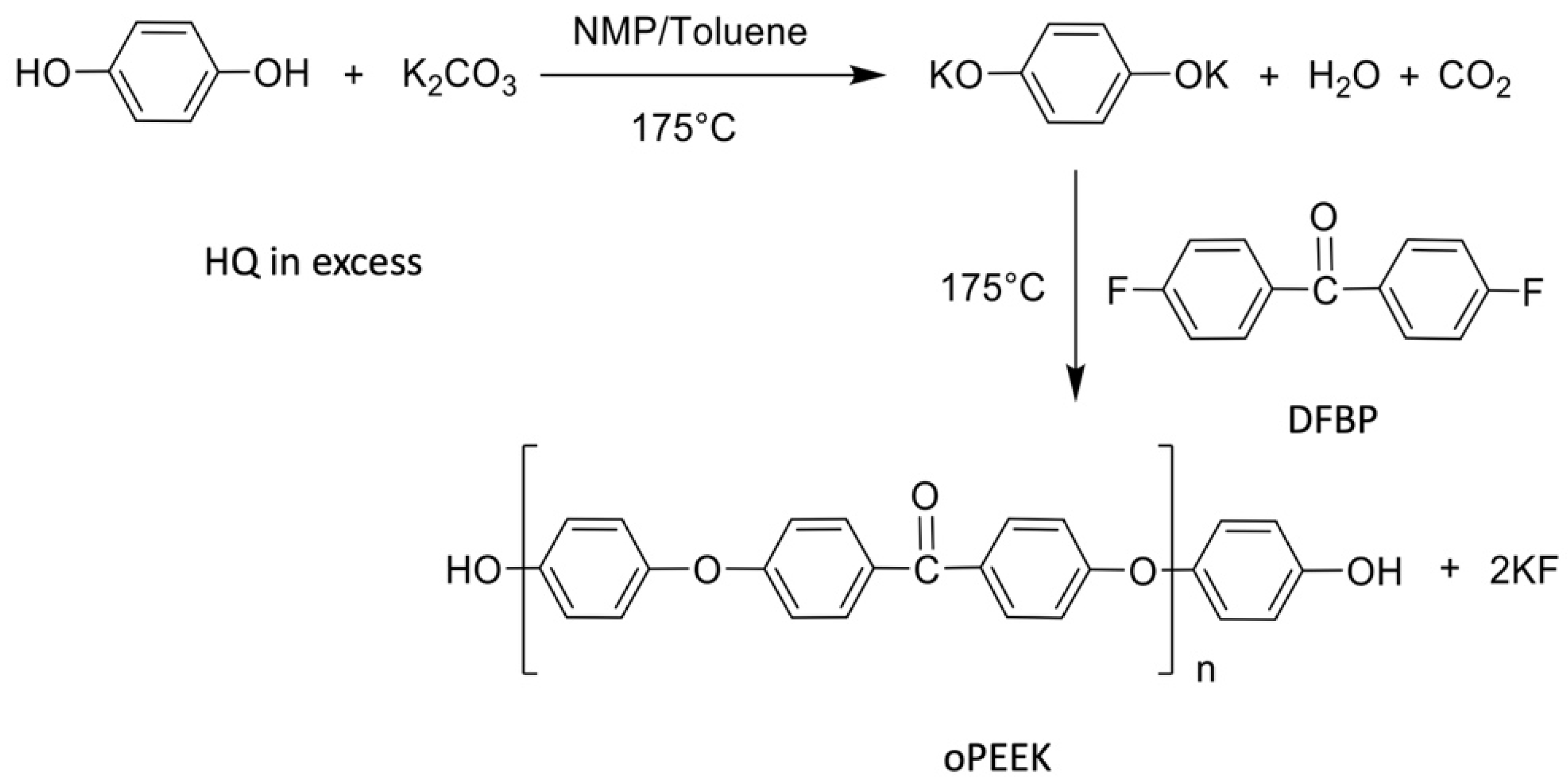


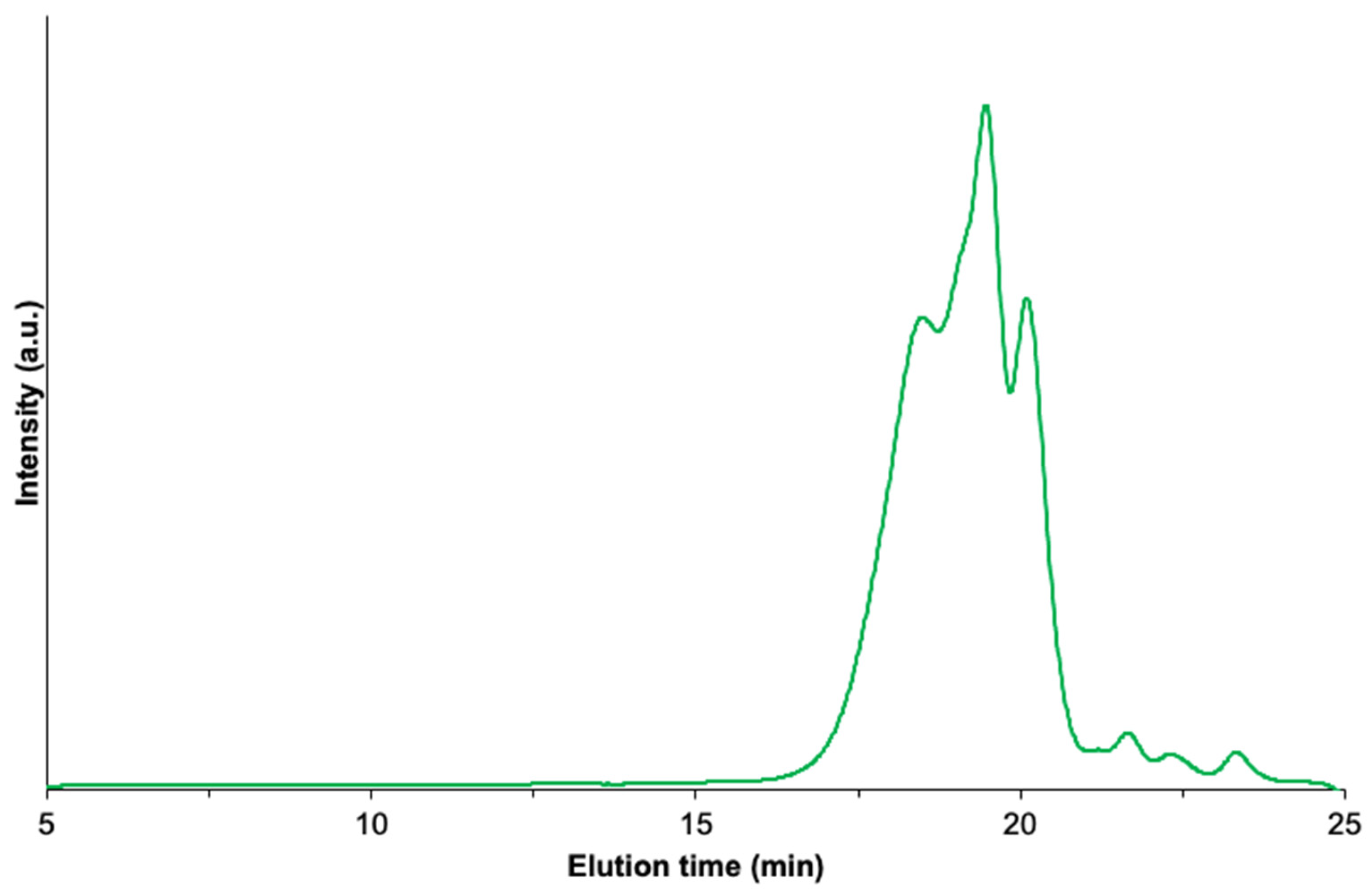
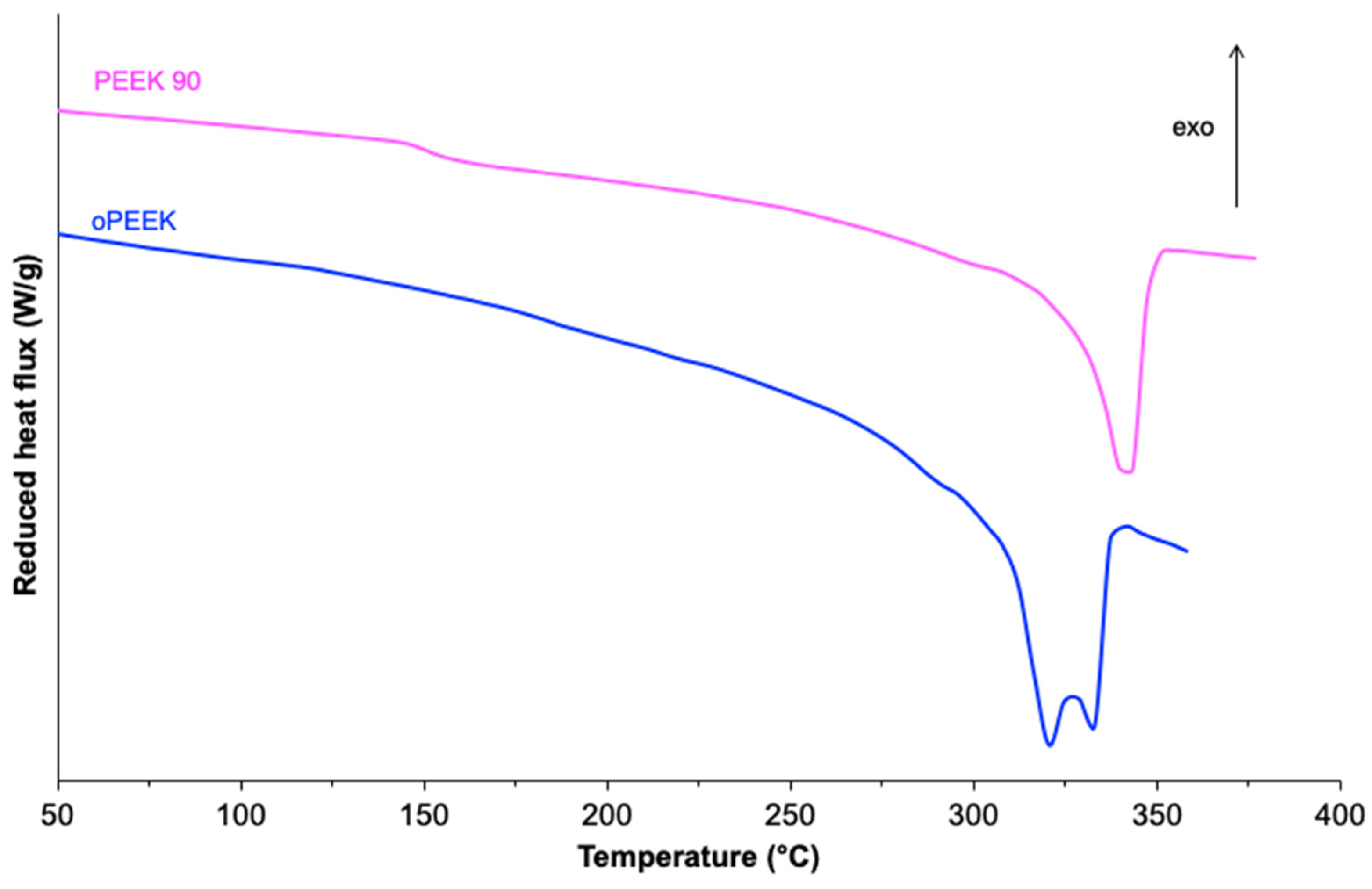

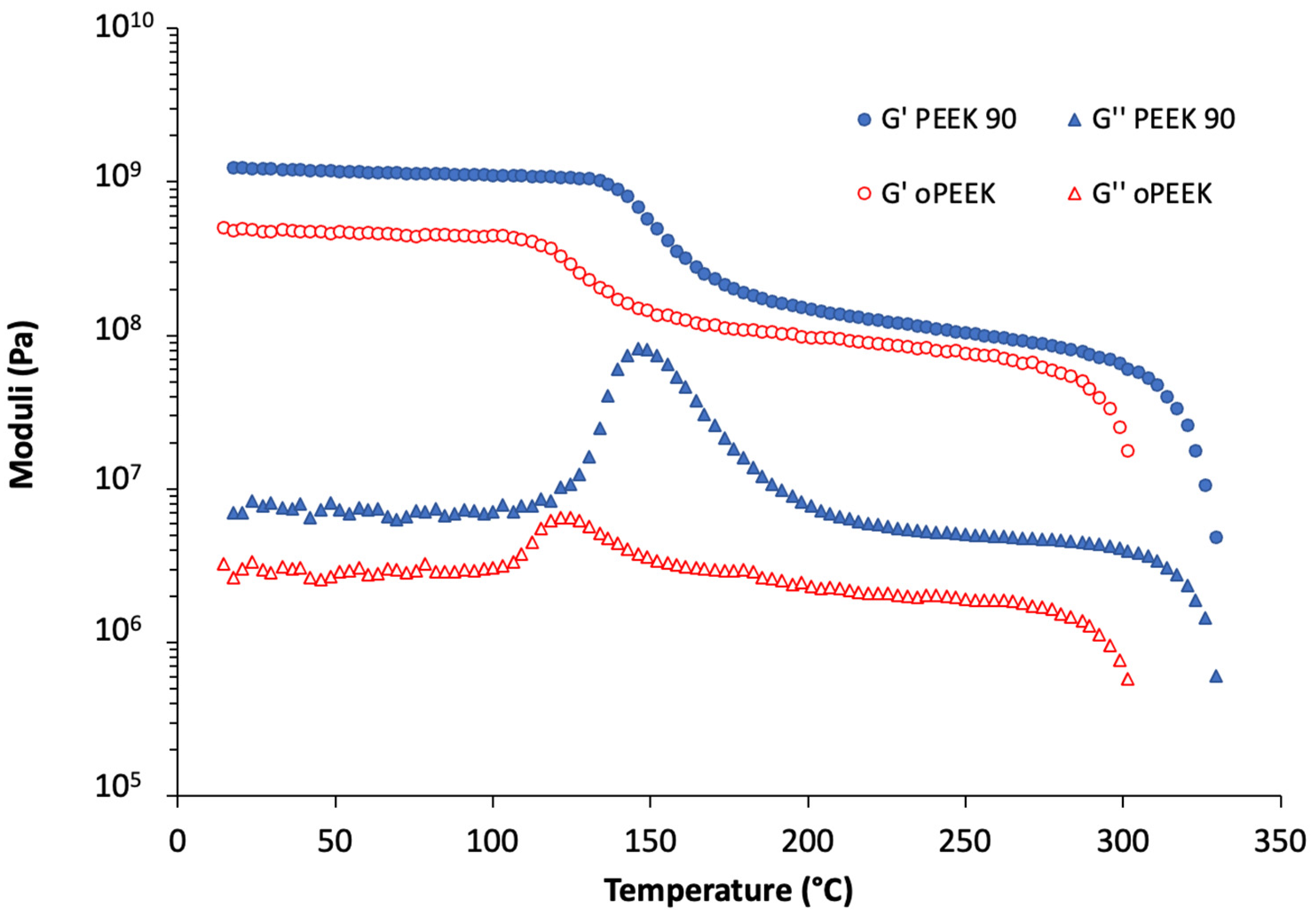
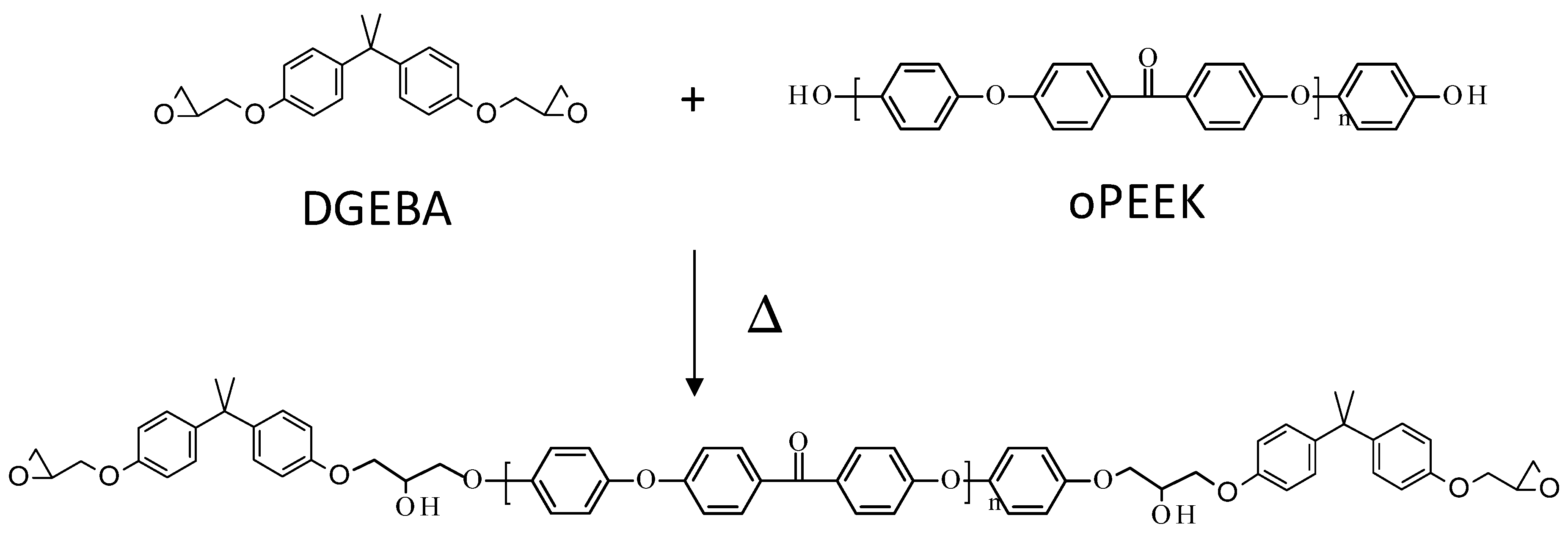
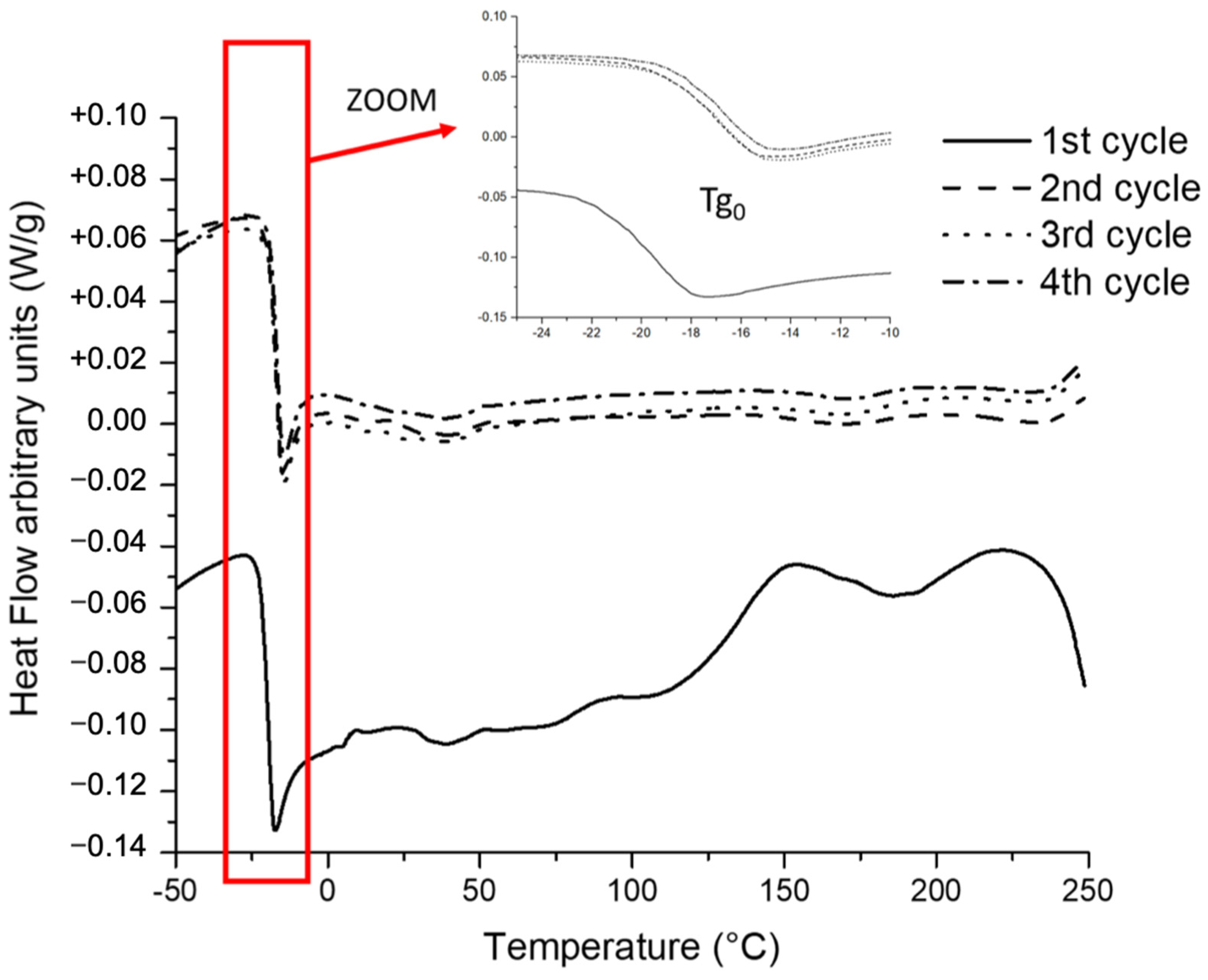
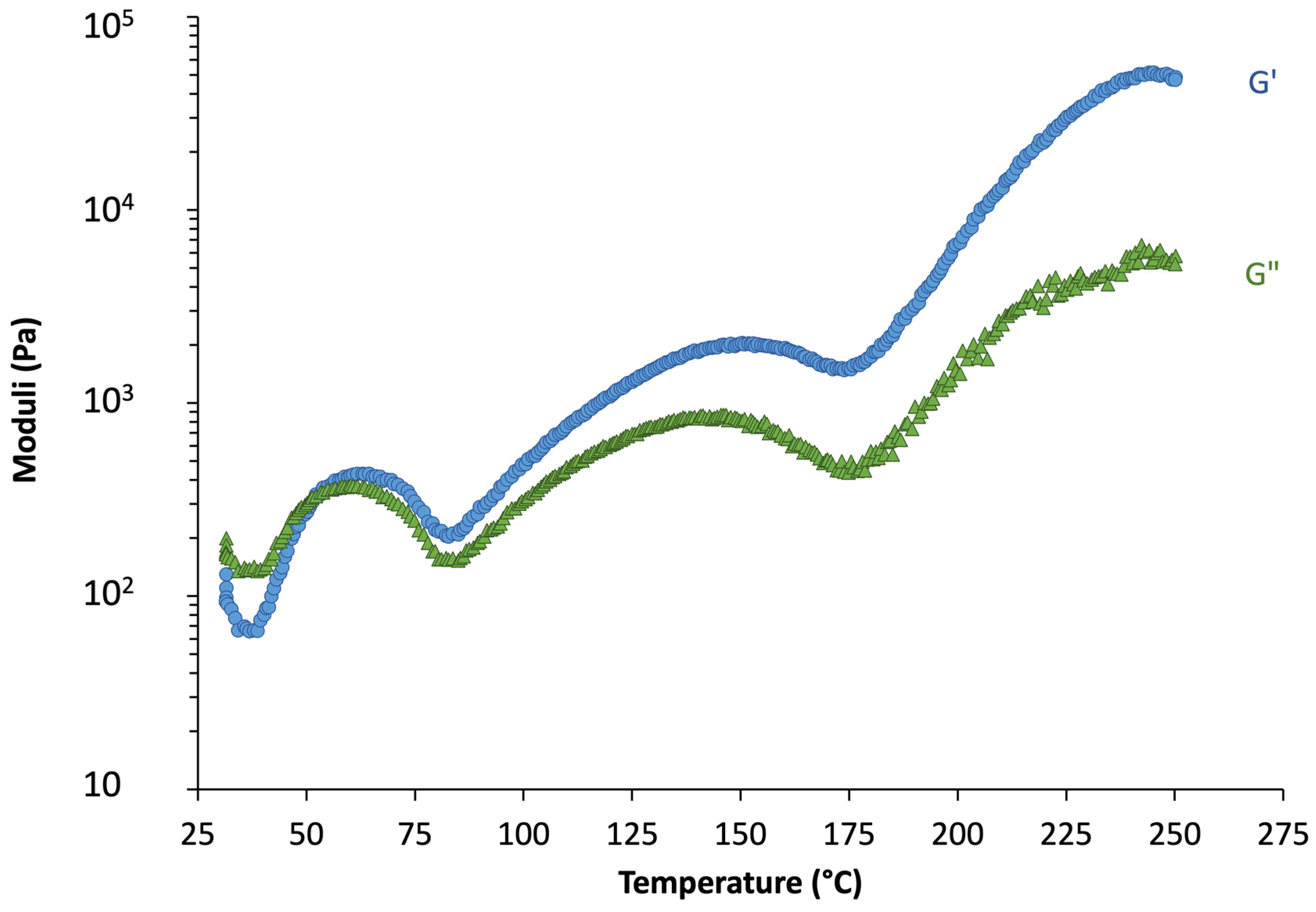
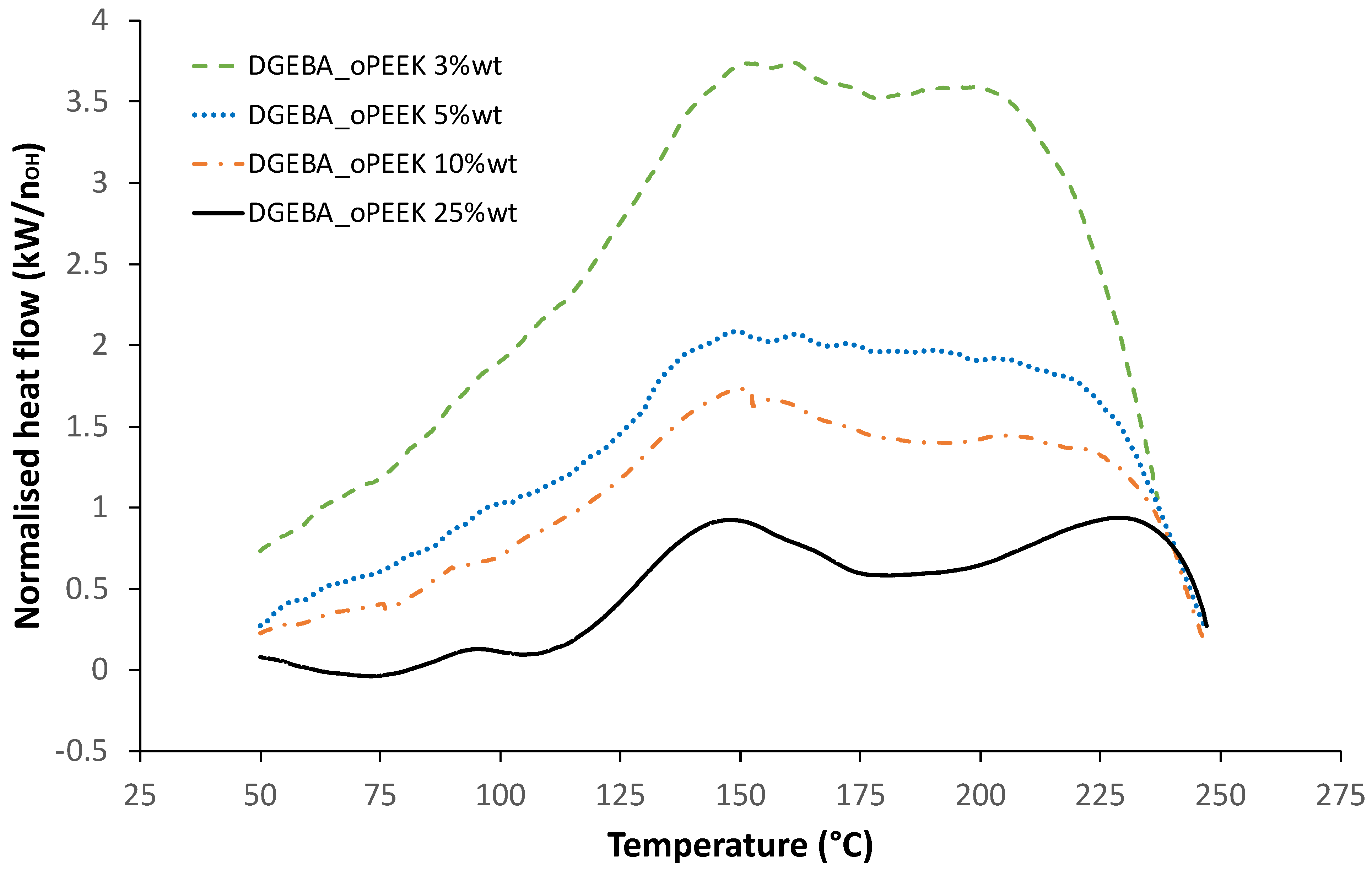

| System | Enthalpy (kJ/nOH) |
|---|---|
| DGEBA-oPEEK 3% | 317 ± 29 |
| DGEBA-oPEEK 5% | 225 ± 21 |
| DGEBA-oPEEK 10% | 177 ± 15 |
| DGEBA-oPEEK 25% | 76 ± 6 |
Disclaimer/Publisher’s Note: The statements, opinions and data contained in all publications are solely those of the individual author(s) and contributor(s) and not of MDPI and/or the editor(s). MDPI and/or the editor(s) disclaim responsibility for any injury to people or property resulting from any ideas, methods, instructions or products referred to in the content. |
© 2024 by the authors. Licensee MDPI, Basel, Switzerland. This article is an open access article distributed under the terms and conditions of the Creative Commons Attribution (CC BY) license (https://creativecommons.org/licenses/by/4.0/).
Share and Cite
Stampfer, L.; Bouilhac, C.; Mérian, T.; Chabert, F.; Djilali, T.; Nassiet, V.; Habas, J.-P. Investigation of the Reaction between a Homemade PEEK Oligomer and an Epoxy Prepolymer: Optimisation of Critical Parameters Using Physico–Chemical Methods. Polymers 2024, 16, 764. https://doi.org/10.3390/polym16060764
Stampfer L, Bouilhac C, Mérian T, Chabert F, Djilali T, Nassiet V, Habas J-P. Investigation of the Reaction between a Homemade PEEK Oligomer and an Epoxy Prepolymer: Optimisation of Critical Parameters Using Physico–Chemical Methods. Polymers. 2024; 16(6):764. https://doi.org/10.3390/polym16060764
Chicago/Turabian StyleStampfer, Léopold, Cécile Bouilhac, Tiphaine Mérian, France Chabert, Toufik Djilali, Valérie Nassiet, and Jean-Pierre Habas. 2024. "Investigation of the Reaction between a Homemade PEEK Oligomer and an Epoxy Prepolymer: Optimisation of Critical Parameters Using Physico–Chemical Methods" Polymers 16, no. 6: 764. https://doi.org/10.3390/polym16060764
APA StyleStampfer, L., Bouilhac, C., Mérian, T., Chabert, F., Djilali, T., Nassiet, V., & Habas, J.-P. (2024). Investigation of the Reaction between a Homemade PEEK Oligomer and an Epoxy Prepolymer: Optimisation of Critical Parameters Using Physico–Chemical Methods. Polymers, 16(6), 764. https://doi.org/10.3390/polym16060764







